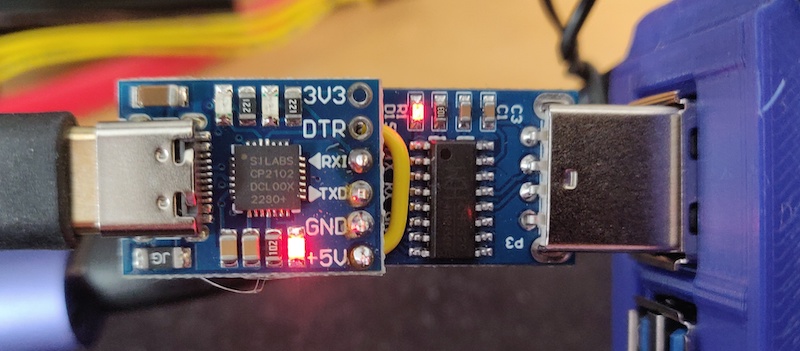PLEASE NOTE: I am a hobbyist. I have no affiliation with any manufacturer developing or selling CH9329 hardware.
A Software KVM, using the CH9329 UART Serial to USB HID controller.
This python module can transmit keyboard and mouse input over a UART serial connection to a second device, using a CH9329 module. You can find these from vendors on eBay and AliExpress for next to nothing. However, there is very little software support available for these modules, and protocol documentation is sparse.
This Python module includes several methods to capture keyboard scan codes from a keyboard attached to the local computer where the script is running, and send them via Serial UART to the device which the USB HID keyboard is listening on. For most purposes, the default mode will suffice.
Run the GUI using python -m kvm_serial:
The module can be installed from PyPI (pip install kvm-serial),
or locally from a cloned git repo (pip install -e .).
The video window is provided using OpenCV, and can be quit using Ctrl+ESC.
A script called control.py is also provided for use directly from the terminal.
(Actually, this is all the kvm.py GUI does: set up the parameters for the script and run it!)
Packages from requirements.txt must be installed first. Use your preferred python package manager. E.g.:
# Conda
conda create -n kvm
conda activate kvm
# OR Venv (don't use both!)
python -m venv ./.venv
./.venv/scripts/activate
# Then, use pip to install dependencies
pip install -r requirements.txtUsage examples for the control.py script:
# Run with mouse and video support; use a Mac OSX serial port:
python control.py -ex /dev/cu.usbserial-A6023LNH
# Run the script using keyboard 'tty' mode (no mouse, no video)
python control.py --mode tty /dev/tty.usbserial0
# Run using `pyusb` keyboard mode (which requires root):
sudo python control.py --mode usb /dev/tty.usbserial0
# Increase logging using --verbose (or -v), and use COM1 serial port (Windows)
python control.py --verbose COM1Use python control.py --help to view all available options. Keyboard capture and transmission is the default functionality of control.py: a couple of extra parameters are used to enable mouse and video.
Mouse capture is provided using the parameter --mouse (-e). It uses pynput for capturing mouse input and transmits this over the serial link simultaneously to keyboard input. Appropriate system permissions (Privacy and Security) may be required to use mouse capture.
Video capture is provided using the parameter --video (-x). It uses OpenCV for capturing frames from the camera device. Again, system permissions for webcam access may need to be granted.
Some capture methods require superuser privileges (sudo), for example pyusb provides the most accurate keyboard scancode capture, but needs to de-register the device driver for the input method in order to control it directly.
For example usage, please see the accompanying blogpost: https://wp.finnigan.dev/?p=682
| Mode | Modifiers | Paste | Blocking | Focus | Exit | Permissions |
|---|---|---|---|---|---|---|
usb |
✅ Yes | ❌ No | ✅ Yes | ❌ No | Ctrl+ESC | sudo / root |
tty |
❌ No | ✅ Yes | ❌ No | ✅ Yes | Ctrl+C | Standard user |
pynput |
✅ Yes | ❌ No | ❌ No | ❌ No | Ctrl+ESC | Input monitoring (OSX) |
curses |
✅ Yes | ❌ No | ✅ Yes | ESC | Standard user |
For curses, modifier support is incomplete but should be good enough to enable working in a terminal. Curses provides a good mix of functionality versus permissions and is therefore the default mode in keyboard-only mode. When running with mouse and video, pynput is selected automatically.
A 'yes' in the remaining columns means:
- Modifiers:
Keys like
Ctrl,Shift,AltandCmd/Winwill be captured. Combinations like Ctrl+C will be passed through. - Paste: Content can be pasted from host to guest. Paste text into the console and it will be transmitted char-wise to the HID device
- Blocking: Keyboard input will not function in other applications while the script is running
- Focus: The console must remain in focus for input to be recorded (and transmitted over the UART)
- Implication: You will need to select the best input method for your use case!
Permissions errors on Linux:
if your system user does not have serial write permissions (resulting in a permission error), you can a
6DC9
dd your user to the dialout group: e.g. sudo usermod -a -G dialout $USER. You must fully log out of the system to apply the change.
Difficulty installing requirements: If you get command not found: pip or similar when installing requirements, try: python -m pip [...] to run pip instead.
With thanks to @beijixiaohu, the author of the ch9329Comm PyPi package and GitHub repo (in Chinese), some code of which is re-used under the MIT License.
(c) 2023-25 Samantha Finnigan (except where acknowledged) and released under MIT License.






